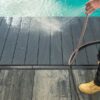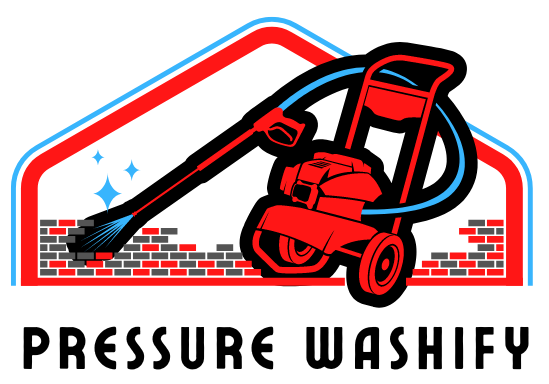Affiliate Disclaimer: This post may contain affiliate links, meaning we get a commission if you decide to make a purchase through our links, at no extra cost to you.
Understanding how to clean stucco without a pressure washer is an essential skill for every homeowner with a stucco exterior. Stucco, with its classic appeal and rugged durability, makes a beautiful siding choice but can become a magnet for dirt, mold, and mildew over time. Consequently, it needs regular cleaning to retain its allure.
While pressure washing could seem like the quickest solution, it can be harsh on the stucco, leading to damage, exposure to elements, and potentially costly repairs. So, how can you safely clean your stucco without resorting to a pressure washer? This blog walks you through practical, DIY methods on how to clean stucco without a pressure washer.
Why Avoiding Pressure Washers is Crucial
Here are some of the reasons pressure washers should be used cautiously or not at all when it comes to cleaning stucco.
1. Chipping and Erosion
Stucco is a porous material, and one of the main concerns when using a pressure washer is the risk of chipping or erosion. High-pressure water can cause the stucco to flake, leading to potential gaps and cracks. This can result in costly repairs, and even worse, compromise the integrity of the stucco.
2. Water Penetration
Another risk with using a pressure washer is the possible forced water penetration into the stucco’s surface. Once water gets inside, it can cause significant issues such as mold, mildew, and rot. These problems are not only unsightly but also hazardous to your home’s structure and your family’s health.
3. Damage to Paint and Sealant
Pressure washing can also strip away paint and sealant applied to the stucco. As a result, you may unknowingly remove the protective layer, leaving the stucco more susceptible to the elements. This could lead to even more repair work in the future.
DIY Stucco Cleaning Solutions
Let’s explore some DIY solutions for cleaning your stucco surface effectively without causing damage. These methods are safe, accessible, budget-friendly, and can work wonders on your stucco.
1. Water and Vinegar Mixture
Vinegar is a fantastic cleaning agent that can do wonders on a stucco surface. To create this solution follow these steps:
- You will need white distilled vinegar, clean water, a bucket or garden sprayer, and a soft-bristle brush.
- Depending on the size of the area you plan to clean, estimate the amount of solution you will need.

3. In the bucket or garden sprayer, combine equal parts of vinegar and water. For instance, if you need one gallon of cleaning solution, use half a gallon of vinegar and half a gallon of water.
4. Stir the mixture until the vinegar and water are thoroughly combined.
2. Laundry Detergent and Water
Your everyday laundry detergent mixed with water can also work well on stucco.
Just be sure to thoroughly rinse the soap off to avoid leaving a residue on the surface.

3. Borax, Water, and Vinegar Solution
A mixture of borax, water, and vinegar is excellent for dealing with stubborn dirt and mildew. The formula?
- Gather Your Materials: You will need water, distilled white vinegar, borax, a bucket, and a soft-bristle brush.
- Determine the Quantity Needed: Depending upon the size of your stucco surface, decide how much solution you need.
- Create the Initial Mixture: Combine equal parts of vinegar and water in the bucket. For example, if you require a gallon of solution, use half a gallon of water and half a gallon of vinegar.

4. Add Borax: Add one cup of borax for every gallon of your initial mixture. This means if you have a half-gallon solution, you’ll need to add a half cup of borax.
5. Stir the Mixture Together: Stir the mixture until the borax is completely dissolved.
Always remember safety; ensure you wear gloves and protect your eyes when using borax.
4. Baking Soda Rinse
Baking soda mixed with water provides a gentle cleaning solution that can brighten up your stucco. This method is particularly ideal for newly painted or delicate stucco surfaces.
How To Clean Stucco Without Pressure Washer: Step-by-Step Guide
1. Protect Surrounding Areas
First off, prepare the area. Cover plants or any delicate features nearby with a protective cloth or plastic sheet to prevent them from getting damaged by the cleaning solution.
2. Make Your Preferred Cleaning Solution
Prepare the DIY cleaning solution of your choice. Be it vinegar and water, laundry detergent, borax, or a baking soda rinse, all these are excellent options.
3. Apply the Solution
Next, apply the solution to the stucco. You can use a spray bottle to saturate smaller, manageable sections, or for larger areas, consider using a garden sprayer. Let the solution sit for about ten to fifteen minutes, but be careful not to let it dry out.
4. Scrub if Necessary
For stubborn stains or heavy grime, a soft scrub brush can be helpful. Gently scrub the affected area in a circular motion to avoid damaging the surface.
5. Rinse the Stucco
Now you are ready to rinse off the cleaning solution. Use a garden hose set at the lowest pressure. Start at the top and slowly work your way down to prevent streaking and help thoroughly remove the solution.
6. Assess Your Work and Repeat if Needed
Once you’ve rinsed off the cleaning solution and allowed the stucco to dry, assess your work. If areas of dirt, mildew, or mold still persist, don’t despair. Repeat the process until you’re satisfied with the result.

Tips for Stucco Maintenance
Here are some tips to keep your stucco in top shape:
1. Regular Cleaning
Don’t wait until grime and mold have taken over to clean your stucco. Regular cleaning helps maintain its fresh look and saves you the trouble of stubborn stains.
2. Routine Inspections
Make it a habit to inspect your stucco regularly. Look out for cracks, discoloration, or any signs of damage. Early detection and timely repairs can save you from serious problems in the future.
3. Protect Against Water Damage
Keep your home’s gutters and downspouts in good working condition. They direct water away from your stucco walls, reducing the risk of water damage and mold.
4. Be Gentle
Remember, stucco is a relatively soft material. Avoid using harsh abrasives or high-pressure water streams that could damage the stucco.
5. Use Quality Paint/Sealant
Applying a high-quality paint or sealant that is designed for stucco can help protect it from the elements. It can lock out moisture, repel dirt, and reduce the risk of cracks and discoloration.
Our Recommendation
Besides maintaining cleanliness, protecting your stucco from potential weather-related damage is crucial. The Eco Advance Concrete/Masonry Siloxane Waterproofer can be an integral part of your stucco maintenance routine.
This product, provides robust protection for your stucco, sealing the surface to guard against water damage. It’s safe for use around plants, pets, and people making it a great choice for households of all types. The application is just as simple as spraying it on, allowing even those new to DIY home maintenance to apply it with ease.
Overall, using this waterproofer post-cleaning can extend the life of your stucco and keep it looking vibrant and fresh. So, when you ponder on how to clean stucco without a pressure washer, remember to consider post-cleaning protection too. The Eco Advance waterproofer can serve as an excellent final step in your stucco cleaning routine.
Eco Advance Masonry Waterproofer

- Effective protection for all surfaces
- Ready to use
- Eco-friendly
- Quick drying
- Long-lasting
Conclusion
Grasping how to clean stucco without a pressure washer is key to maintaining the charm of your home’s exterior without causing any harm. With these simple, yet effective DIY solutions, you’re now well-equipped to handle that task with confidence.
Whether it’s the easy vinegar and water mix, the robust borax solution, the ever-available laundry detergent, or the gentle baking soda rinse, you’re on your way to restoring your stucco’s glory without the perils of pressure washing.
Alongside the practical knowledge of how to clean stucco without a pressure washer, ingraining the routine of periodic cleaning and maintenance is your sure-fire recipe for success. This way, you can enjoy the allure of clean and vibrant stucco for years on end.
In case you ever encounter a particularly stubborn stain or a maintenance challenge beyond your ability, don’t shy away from calling in a professional. It’s all about ensuring your beloved home lasts as a shining beacon of your pride.
Frequently Asked Questions (FAQs)
1. Q: Can I use a pressure washer if I’m extremely careful?
A: Even with great care, the water pressure can potentially damage your stucco surface and cause water to penetrate through cracks. Therefore, we advise against the use of pressure washers on stucco.
2. Q: Are these DIY solutions safe for all types of stucco?
A: Most of these solutions are gentle and safe for use on stucco. However, always test on a small, hidden area first to ensure there are no unwanted side effects.
3. Q: How often should I clean my stucco exterior?
A: The frequency of cleaning depends on your local climate and environmental conditions. However, a general rule of thumb is to clean your stucco at least once a year.
4. Q: Are there professional stucco cleaners that I can hire?
A: Yes, professional exterior cleaning companies can offer services specifically tailored for stucco to ensure it’s cleaned safely.
5. Q: Can I use any type of paint or sealant on my stucco?
A: Not all types of paint and sealants are suitable for stucco. It’s recommended to use a paint or sealant specifically designed for stucco surfaces like the Eco Advance Concrete/Masonry Siloxane Waterproofer which is designed for safe use with all surfaces including stucco.
6. Q: What should I do if I notice cracks or damage on my stucco?
A: If you notice any damage, it’s essential to get it repaired promptly to prevent water intrusion. Contact a professional stucco repair service if necessary.









